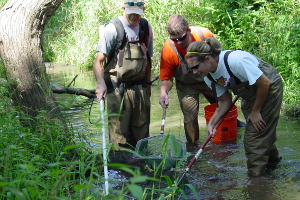Biological Monitoring
Routine chemical analyses of water samples provide water quality information for just a moment in time and short-term pollution events may occur undetected. Chemical analyses also provide no indication of the physical nature (habitat complexity) of a stream, just as habitat assessments do not address a stream's chemical quality. Because the biological community of a stream is a reflection of the chemical and physical quality, a better overall view of stream health is obtained by characterizing stream inhabitants. The Limnology Section is presently sampling fish and benthic macroinvertebrates (generally bottom dwelling insects) for water quality projects across the state and the number of studies requesting biological monitoring has steadily risen in recent years. The primary statewide projects involving stream biological sampling are administered by IDNR's Water Monitoring and Assessment Section. They have developed and are refining measures of biological integrity that rate the quality of Iowa streams based on the fish and invertebrate communities present during these studies.
Benthic Macroinvertebrate Surveys
Invertebrates that live in, on, or around the bed or bottom of an aquatic system are considered to be benthic in nature. They have also proven to be excellent biological indicators of water quality. Specific taxonomic groups of benthic organisms have less tolerance for pollutants than other groups. The SHL limnologists have focused on the usefulness of benthic organisms in assisting with their evaluations of the water quality of Iowa's rivers, lakes and streams. In general, good quality streams show greater overall invertebrate diversity and greater diversity and abundance within the sensitive mayfly, stonefly and, caddisfly goups. Currently, the Limnology section has projects that require collecting benthic macroinvertebrates statewide.
Historically, Iowa's aquatic macroinvertebrate (primarily insect) fauna has been poorly surveyed and/or documented. Dozens of new state records (occurrence of species not found in the state previously) have been recorded in recent years, primarily as a result of increased sampling effort associated with these stream bioassessment projects. Access Iowa's Aquatic Macroinvertebrates on-line and follow the links for several of the major groups of aquatic insects- stoneflies, caddisflies, mayflies, dragonflies/damselflies. The following organizations may also be of interest- Illinois Natural History Survey, Kansas Entomological Society and the Society for Freshwater Science (formerly the North American Benthological Society). Contact us for hard copies of recent papers summarizing Iowa's mayflies and stoneflies or read on-line. Publications summarizing Iowa aquatic beetles and caddisflies are in process.
Fish Surveys
From small coldwater trout streams, to natural lakes and large warm rivers, the state of Iowa has a variety of waters that support about 140 species of fish. As with macroinvertebrates, fish display varying habitat requirements and water quality tolerances making them excellent indicators of stream health. Nearly two thirds of Iowa's species are small, with adults generally less than six, and often, less than four inches long. Darters, sculpins, some minnows, and larger non-game fish like suckers are often more sensitive to degraded conditions than the familiar gamefish.
Predatory and bottom feeding species also tend to bioaccumulate certain contaminants in their tissues. Some projects involve the collection of fish tissue samples as a means of monitoring contaminant levels in the aquatic environment and identifying potential health concerns related to human consumption of fish.
Though Iowa fish have been better studied than aquatic invertebrate fauna, the increased sampling effort in recent years has provided information on changing abundances and ranges of fish in the state. Some species have been found to occur in many more places than previously thought, while others have shown dramatic declines in the last few decades. The Iowa Rivers Information System (IRIS) has compiled fish collection data from studies spanning over 100 years. You can also visit the EPA's web page for the National Listing of Fish Advisories (NLFA).
Algae, Macrophytes, and Chlorophyll
Algae and macrophytes (aquatic plants) also reflect the water quality and a physical component of aquatic systems. The Limnology Section has examined periphytic (living on hard surfaces like rocks) diatoms (type of algae) in streams above and below wastewater discharges but recent stream assessments have rarely included algae or macrophyte surveys. Current Total Maximum Daily Load (TMDL) lake assessments involve phytoplankton (algae) and zooplankton (microinvertebrates) counts and macrophyte surveys. Analysis for chlorophyll is also completed in the Limnology Section. Chlorophyll is a commonly requested analyte in water samples from streams and lakes. The analysis is also performed on periphyton and terrestrial vegetation.



